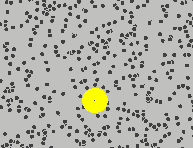The Law of Conservation of Idea
Table of Contents
Principles (click to expand)
| Principles | Assertions |
|---|---|
| Each Idea is Unique | Movement Comes from the Objects Preserving their Uniqueness |
Chapter 1 explained the Existence began when the Absolute Entity destabilized Itself to create waves of ideas which transformed It into the Supreme Entity.
This Existence Itself is an idea of the Consciousness of the Absolute, leading to Existence-Consciousness or the Supreme Entity.
This Existence-Idea has subideas within It as universes, dimensions, densities, etc. according to the pyramid or tetrahedral structure of the compound ideas and simple ideas.
Unity Leading to Conservation Leading to Constants
The active form of Existence uses wave dynamics. Chapter 1e explained that the first property of which is conmonality or continuity.
This manifests as the “No Void” rule of motion. This means that a change in one part of Existence will necessarily affect the other parts.
This is similar to Brownian motion where a change in one particle affects all others next to it, and then those particles affect those next to them.

This one particle affecting others is now known as the Law of Conservation of Momentum which is a conservation law.
Rene Descartes first proposed conservation as preservation by Nature, leading to the Laws of Nature:
“Nature” here means the aether itself, assuming that God continues to preserve it in the same way that He created it. There are many changes in the aethereal particles that are not caused by the action of God. This means that those changes are from nature as the aether itself.
- It follows that God continues to preserve the aether.
- The rules on how the changes in the aether take place I call the “Laws of Nature”
Rene Descartes
The World, Chapter 7
The many conservations laws in Physics are just different versions of the unity of Existence as a single unit we call the Supreme Entity.
We call the highest conservation law as The Law of Conservation of Idea. This states that all ideas:
- already pre-exist or had no beginning*
- cannot be created nor destroyed, as having no end, and
- are unique
Superphysics Note
This uniqueness means that each idea has its own properties as imbued by its Creator.
- These inherent properties are called its dharma or true nature.
- The inherent property of a unique idea or object is called svadharma
This law explains the principles in various sciences, such as:
- The mind having only one thought at a time in Psychology
- The Pauli Exclusion Principle in Physics
- A territory having only one state in Politics
Why Must Identities Be Unique?
Chapter 1 explained that the purpose of Existence is to expose, realize, or appreciate the value of the Absolute Entity.
This perfect value already pre-exists, but the appreciation of that value does not exist immediately.
And so the Absolute splits Itself up using Its own Negative Force and then enjoys Its Split-up Selves through the Positive Force that unites those Selves.
And so having a duplicate of any part would mean that there was another Absolute Entity. This would then logically go against the definition of “Absolute”.
This is similar to asking what existed before existence, which we solve by creating the concept of “Pre-Existence”.
Likewise, we solve the illogical question of second Absolute Entity by rejecting the possibility of totally-identical parts in Existence.
In Nature, there are never 2 beings which are perfectly similar to each other, with no internal difference.
Leibniz
Monadology, Article 9
Note that this principle of uniqueness is far more subtle, profound, and useful than the concept of Pre-Existence which really just acts as a sink for overthinking.
So What’s the Use of the Law of Conservation of Idea?
The Law of Conservation of Idea leads to:
- svadharma and gravitational signatures which lead to action which leads to relationality
- constants and relationality